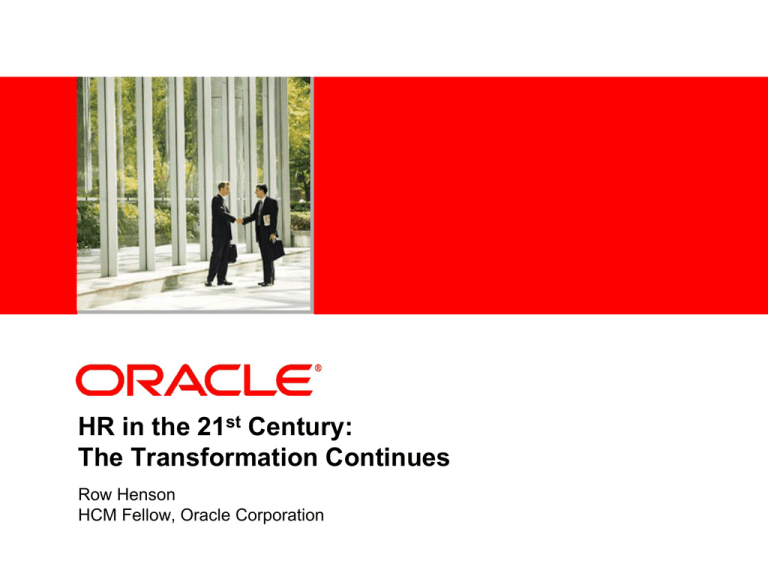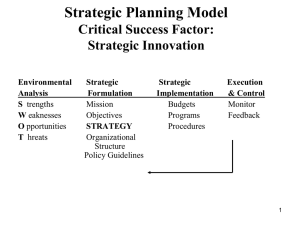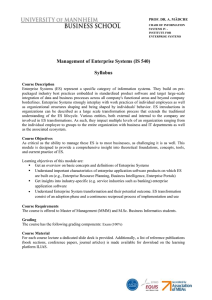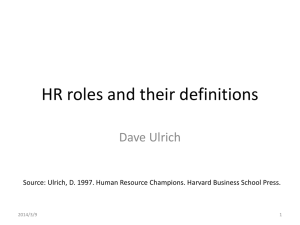Title page (default type size = 40 pt Times New Roman)
advertisement

<Insert Picture Here> HR in the 21st Century: The Transformation Continues Row Henson HCM Fellow, Oracle Corporation Convergence of the .(dot) Shifts Business 2.0 HCM 2.0 Web 2.0 = Transformation 2.0 Evolution for HCM New Technological Paradigm Yesterday’s Technology Platform Web 1.0 versus Today’s Technology Environment Web 2.0 • • • • Systems Agility Collaboration / Sharing Extended / Global Efficiency / Effectiveness New Demands for HCM New Workplace Demands Yesterday’s Business Agenda Work 1.0 versus Today’s Business Imperative Work 2.0 New Workforce Demands Yesterday’s Human Resource Labor versus Today’s Human Capital People New Workforce Demographics Yesterday’s HRIS Application HRIS • • • • versus Today’s HCM Suite HCMS Business Agility Engagement / Retention Workforce Intelligence Business Performance Agenda • • • • • • • HR Transformation 1.0 1995 - 2004 HR Transformation 2.0 2004 – beyond HR Transformation Report Card HR Transformation Competencies The Future of the Workforce Technology Foundation – Web 2.0 Measuring the Impact of Talent on Business Results Reengineering Human Resources 1995 HR Transformation – A Global Thing • Over 75% of firms involved in HR transformation efforts • US leads in completed projects • Huge number of “in process” HR transformations elsewhere • Only a few HR leaders have no plans Source: Mercer HR Consulting Global HR Transformation Study, 2004 It’s About Time (Spent) After 10+ years talking about being more strategic…not enough progress! Source: Mercer HR Consulting Global HR Transformation Study, 2004 Agenda • • • • • • • HR Transformation 1.0 1995 - 2004 HR Transformation 2.0 1996 – beyond HR Transformation Report Card HR Transformation Competencies The Future of the Workforce Technology Foundation – Web 2.0 Measuring the impact of Talent on Business Results What is HR Transformation 2.0 Mercer 2006 Transformation Study Mercer 2006 Transformation Report Agenda • • • • • • • HR Transformation 1.0 1995 - 2004 HR Transformation 2.0 1996 – beyond HR Transformation Report Card HR Transformation Competencies The Future of the Workforce Technology Foundation – Web 2.0 Measuring the impact of Talent on Business Results Transforming HR •One size does not fit all •Process flexibility and adaptability •Innovate or be outsourced •Business partner/business alignment •Owner of corporate culture/ employee brand •Competency/talent identification & development •Project management skills •Better analytical skills Future skill requirements for HR professionals – Mercer 2006 report • • • • • • • • • • • • Interpersonal skills Team skills Interviewing and assessment Consultation/negotiation skills Leadership Change management Cultural change/transformation skills Business understanding Conflict management Coaching/facilitation Customer service HRIS data analysis and reporting Agenda • • • • • • • HR Transformation 1.0 1995 - 2004 HR Transformation 2.0 1996 – beyond HR Transformation Report Card HR Transformation Competencies The Future World of Work Technology Foundation – Web 2.0 Measuring the impact of Talent on Business Results Future World of Work • • • • What will the workforce look like? Where will the talent come from? Workplaces or workspaces? Who owns the talent pool and the company culture? • How do we prepare for these changes? Workforce Demographics • • • • • • • • Reduced Workforce Workforce is getting older 3 Generations working together Increase of women in the workforce Rise in the contingent workforce Global, mobile, virtual worker Decline in education level in developed countries Dominant language in next 50 years – Chinese? Each generation in the workplace comes with its own sets of experiences and expectations that can occasionally come in conflict with one another Traditionalist Boomer The hard way Too much and I’ll leave Required to keep me Continuous & expected Classroom Facilitated Independent Collaborative & networked Communication style Top down Guarded Hub & spoke Collaborative Problem-solving Hierarchical Horizontal Independent Collaborative Decision-making Seeks approval Team informed Team included Team decided Leadership style Command & control Get out of the way Coach Partner No news is good news Once per year Weekly/daily On demand Uncomfortable Unsure Unable to work without it Unfathomable if not provided Unwise Sets me back Necessary Part of my daily routine Training Learning style Feedback Technology use Job changing Gen X Gen Y Source: Lancaster, L.C. and Stillman, D. When Generations Collide: Who They Are. Why They Clash. How to Solve the Generational Puzzle at Work. Wheaton, IL. Harper Business, 2003. Agenda • • • • • • • HR Transformation 1.0 1995 - 2004 HR Transformation 2.0 1996 – beyond HR Transformation Report Card HR Transformation Competencies The Future of the Workforce Technology Foundation – Web 2.0 Measuring the impact of Talent on Business Results Common Web 2.0 Tools Blogs Interactive discussion led by one individual Wikis Fully collaborative document/website creation Social Bookmarking Track interests and share with others Social Software Organize and connect with others with similar interests RSS Feeds Subscribe to news and changes – syndication Chat Private one-on-one or group interaction Virtual Worlds Meet and interact with others in a virtual world Tomorrow’s Web 2.0 Work Environment KIA Research Q3 Budget Review Capital Expenses, KIA Analysis Employee Reviews Acquisition Analysis Stress Reduction Tips Q2 Competitive Analysis Evolving HR Practices Engager Traditional Internet Web 2.0 Visibility All Hands Meetings Replayable Webcasts Interactive blogs Development Classroom training eLearning Informal learning, tagging Community Team building offsites D-lists, webinars Social networking, workspaces Recognition Plaques Email announcements Recommendations, kudos, ratings Empowerment Employee surveys Online surveys Wikis, chats, forums Attraction Job Fairs, word of mouth Online advertising, Email referrals Blogging, RSS, Social networking Who’s Adopting Web 2.0? Executives Worldwide: >75% plan to maintain or increase their investments that encourage user collaboration, social networks, etc. 66% regret not boosting their capabilities to exploit new technologies. More executives said they should have acted faster. The McKinsey Quarterly conducted this survey in January 2007 and received responses from 2,847 executives worldwide, 44% hold C-level positions. What Web 2.0 Technologies are Being Adopted? Blog 32% Wiki 33% Podcasts 35% RSS 35% Social Networking Collective Intelligence Use or Planning to Use 39% 48% Web Services The McKinsey Quarterly conducted this survey in January 2007 and received responses from 2,847 executives worldwide, 44% hold C-level positions. 80% Agenda • • • • • • • HR Transformation 1.0 1995 - 2004 HR Transformation 2.0 1996 – beyond HR Transformation Report Card HR Transformation Competencies The Future of the Workforce Technology Foundation – Web 2.0 Measuring the impact of Talent on Business Results Measuring Human Capital Asset People as Means People as Capital Loss Profit People as Problems Liability Source: Chapman Condy Company People as Costs Why Measure? • STOP: “I think….I feel” • START: “I know…I can prove” • SHIFT: From Tangible to Intangible Asset Accounting Changing the questions that we ask FROM… TO… • How do we prove the worth of • How do we identify those HR the HR function? programs/policies that would have the greatest positive impact on our key performance indicators? Source : Laurie Bassie – McBassie & Company Changing the questions that we ask FROM… TO… • How do we show a ROI (cost savings) on our HR interventions? • How do we link our HR interventions to key performance indicators? Source : Laurie Bassie – McBassie & Company Changing the questions that we ask FROM… TO… • How do I justify/increase our training budget? • What are the key differences in the training histories of our top and bottom performers? Changing the questions that we ask FROM… TO… • How do we maximize employee engagement? • What are the critical engagement differentials between top and bottom performing business units/functions? Source : Laurie Bassie – McBassie & Company Metrics That Matter: Analytic Taxonomy Predictive Modeling I M P A C T Correlated Analytics Contextual Embedded Analytics Metrics Delivery (Dashboards) Information Distribution COMPLEXITY Business Evolution From the Industrial Age to the Knowledge Age Confluence of HR, Technology and Business CHRO / CPO Human Capital Knowledge Strategy Global Manufacturing MRP VPHR Legal Protector Competencies Local Finance Host Systems Personal Dir Recordkeeping Skills People Opportunity Creation / Effectiveness Efficiency Process ERP Automation Data Mainframe Packages Host Client/ Server Internet Technology Evolution <Insert Picture Here> Questions? For more info. Contact row.henson@oracle.com Enjoy the rest of the meeting!





